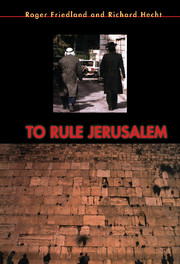Book contents
- Frontmatter
- Contents
- List of Illustrations
- Preface
- Acknowledgments
- Introduction
- 1 A Fearful Fusion
- Part I The Two Zions: Jews Against Zionism in Jerusalem
- Part II Zion Divine: Jerusalem as the Messianic Central City
- 6 A Few Footsteps for the Messiah
- 7 Staking the Claim in Judea and Samaria
- 8 Building the Capital
- 9 Suburbs of the Messiah
- 10 Defensible Borders
- Part III Birth of a Nation
- Part IV Heart of Stone
- Notes
- Index
8 - Building the Capital
Published online by Cambridge University Press: 13 May 2010
- Frontmatter
- Contents
- List of Illustrations
- Preface
- Acknowledgments
- Introduction
- 1 A Fearful Fusion
- Part I The Two Zions: Jews Against Zionism in Jerusalem
- Part II Zion Divine: Jerusalem as the Messianic Central City
- 6 A Few Footsteps for the Messiah
- 7 Staking the Claim in Judea and Samaria
- 8 Building the Capital
- 9 Suburbs of the Messiah
- 10 Defensible Borders
- Part III Birth of a Nation
- Part IV Heart of Stone
- Notes
- Index
Summary
Jerusalem is a wise old town. Things will come and things will go, and it always has its very calm hysteria.
– Elinoar Barzaki, Jerusalem's chief engineerAs Israeli troops stormed onto the Temple Mount in 1967, a Jewish state controlled this ancient site of sacrifice to the one God and symbol of sovereignty of the one people for the first time in two thousand years. One soldier thought it natural to raise the Israeli flag from the dull black dome of al-Aqsa mosque, once a stable for the Knights Templar. Moshe Dayan, the minister of defense, ordered it taken down. The Muslims would keep the platform they called the haram as-sharif, and the Jews would again pray below the complex at its outer “Western Wall.” When Israelis first touched this wall, many wept uncontrollably. Israel's prime minister, Levi Eshkol, pressed his body, arms outstretched, against the wall as if to embrace it for the nation, sovereign flesh against sacred stone. The Western Wall became a site where soldiers were initiated into elite military units, where Israel commemorated the sacrifice of its soldiers.
The Israelis believed that by dividing the holy places between Muslims and Jews, they could unite this city of Arabs and Israelis. Moshe Dayan removed the barbed wire, the mine fields, and the walls dividing Jerusalem, and a remarkable young mayor, Teddy Kollek, elected two years before, began to govern the city in a way he hoped would serve Arab and Jew alike.
- Type
- Chapter
- Information
- To Rule Jerusalem , pp. 180 - 199Publisher: Cambridge University PressPrint publication year: 1996

